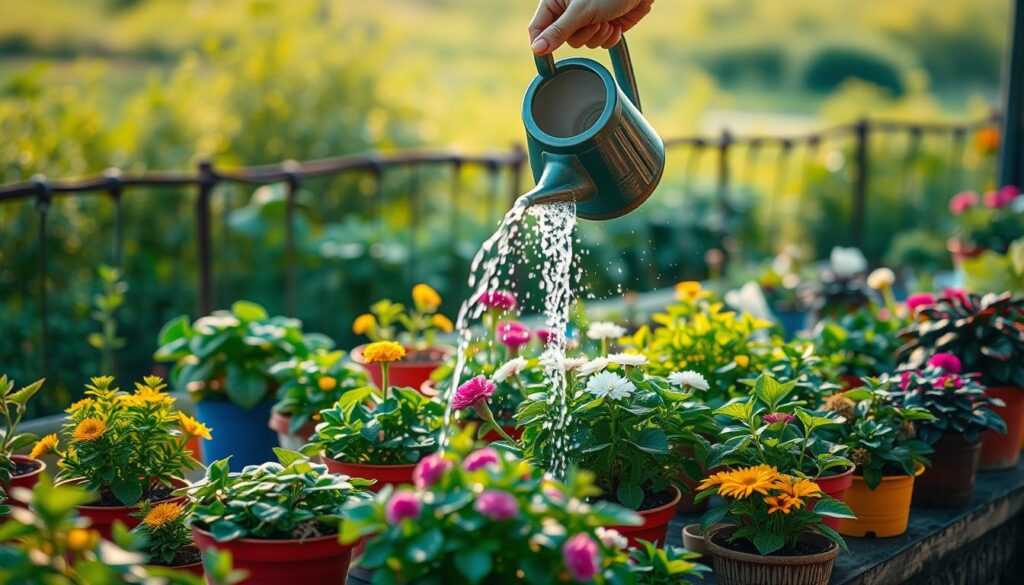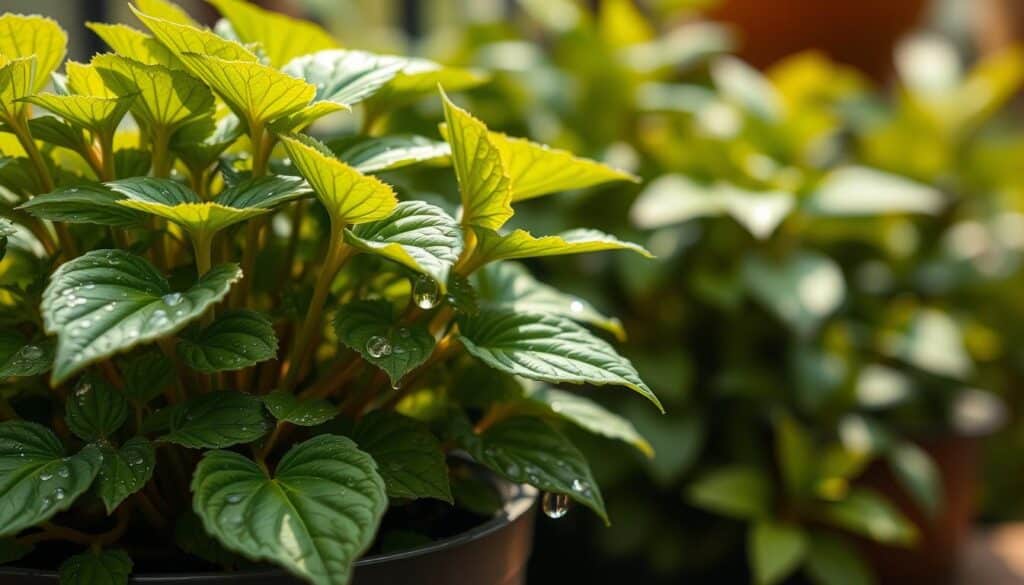Optimal Watering Plants Guide & Tips | Garden Care

About the Game
Getting the water needs of your plants right is key to a thriving garden. Different plants need different amounts of water. This guide will cover irrigation methods and tips for better plant health and less water waste.
Understanding the Importance of Watering Plants
Water is crucial for keeping plants healthy. It moves nutrients throughout the plant, which is essential. Without enough water, plants can’t do important tasks like photosynthesis.
Watering the right way helps plants handle tough situations. It makes them stronger against pests and diseases. With enough water, plants can better handle challenges.
Anúncios
The weather affects how much water plants need. Changes in seasons change how water evaporates and how moisture stays in the soil. During extreme weather, plants may need different amounts of water.

Anúncios
How Much Water Do Plants Really Need?
Knowing how much water plants need is key for gardeners. Most of the time, plants do well with one inch of water every week. However, this can change based on the type of plant, where you live, and the soil.
To figure out when to water plants, checking the soil’s moisture is important. Dig down six inches into the soil to see if it’s moist. This helps make sure plants get enough water but aren’t drowning. By watching how quickly the soil dries up and changing when you water plants, you can keep them healthy. This avoids giving them too much or too little water.
Effective Techniques for Watering Plants
It’s key to know the right way to water plants for their health. Choosing between deep watering and frequent light watering makes a big difference. It impacts how well roots grow and how plants handle stress. Using the right method at the right time can really boost your garden.
Watering Deeply vs. Watering Frequently
When you water deeply, the moisture reaches far down to the lower roots. This helps plants grow strong, deep roots. On the flip side, watering a little but often only moistens the top soil. This can lead to weak roots that don’t go deep into the ground. Weak roots mean the plant might not get enough water when it’s dry. Try to deeply water your plants once or twice a week for the best results.
Best Time to Water Your Plants
The time of day you water plants is super important. Morning is usually the best time. This lets plants soak up water before it gets too hot, allowing the water to go deep into the soil. Watering in the evening can be risky. It might leave leaves wet all night, which can cause fungus. Watering at the right time helps keep plants healthy and saves water too.
Choosing the Right Watering Tools for Your Garden
Choosing suitable watering tools is vital for a healthy garden. There are many options, each made for certain needs. Watering cans are great for small spots and potted plants, as they let you control water flow. Meanwhile, garden hoses offer flexibility and are perfect for bigger areas, making it easy to water plants that are far away.
If you want to make watering your garden simpler, consider irrigation systems. These systems distribute water evenly, making the gardener’s job easier. Drip irrigation is especially good, as it sends water straight to the roots and cuts down on water loss.
Think about your garden’s size and the type of plants you have when picking tools. Sometimes, using a mix of tools, like hoses and sprinklers, works best for different watering needs. Knowing what your garden needs is key to choosing the right tools and systems.
Key Considerations for Watering Newly Planted Vegetation
New plants need careful attention so they can grow strong roots and do well. Their roots aren’t deep in the soil yet, which makes them more likely to dry out. It’s very important to follow the right watering steps early on. This helps avoid stress and wilting. We will look at the best ways to care for young plants and special tips for those in containers.
The Needs of Young Plants
Young plants have different watering needs than older ones. They need to be watered often to keep the soil moist. Here are the main things to keep in mind:
- Water deeply to encourage roots to grow downwards.
- Check moisture levels daily, as new plants can dry out quickly.
- Consider the plant type; some may require more water than others.
Container Plant Watering Guidelines
Plants in containers need extra care compared to those in the ground. Because pots hold less soil, they lose water fast when it’s hot. Here are some important tips for looking after container plants:
- Water many times a day when it’s very warm.
- Use pots with drainage holes to avoid root rot.
- Add a layer of mulch on top of the soil to keep it moist.
The Role of Soil Moisture in Plant Health
Soil moisture is key to plant health. It helps plants to get nutrients better, crucial for their growth. If moisture is low, plants can get stressed and unhealthy.
It’s important to keep soil moisture right for plants to work well. Watering the right amount makes a good space for roots. Adding stuff like compost helps soil hold water better and fights drought.
Gardeners should always check soil moisture. Knowing how wet the soil is helps choose when and how much to water. This makes sure plants get just what they need.
Seasonal Changes: Adjusting Your Watering Routine
Understanding your plants’ water needs is crucial, especially with changing seasons. Weather changes call for different watering methods to make sure plants stay healthy. During dry periods, water your plants more often. But, winter needs its own watering plan.
Watering During Drought Conditions
In drought times, plants get stressed and might need to be checked every day. When it’s hotter than 85°F, keep an eye on the soil. If you see wilting or the soil feels dry, your plants need water. Changing how you water in these times helps plants cope better.
- Water early in the morning to minimize evaporation.
- Utilize drip irrigation systems for efficient moisture delivery.
- Focus on deep watering techniques to encourage root growth.
Winter Watering Tips
When it gets colder, plants don’t need as much water because they slow down. But, you still need to water them in winter to avoid drying out. It’s key to keep up with watering, especially for plants that are asleep. Here are some tips for winter:
- Water plants during warm spells in winter to sustain moisture.
- Avoid overwatering, as excess moisture can lead to root rot.
- Monitor evergreens specifically, as they may need more hydration during the colder months.
Understanding Plant Signs of Water Stress
It’s key to spot when plants are too thirsty or drowning. Gardeners often struggle to tell if they are overwatering or underwatering. Both situations look alike in plants, so knowing what to do is crucial.
Overwatering vs. Underwatering Symptoms
Too much water can rot the roots, while too little dries them out. Common signs of both include:
- Wilting leaves as a sign of both overwatering and underwatering
- Yellowing leaves indicating stress from excess moisture or lack of hydration
- Drooping stems which can result from both conditions
Checking soil moisture helps figure out water stress. This lets gardeners know when to water more or less. It helps avoid the problems of too much or too little water.
Using Mulch to Retain Moisture
Putting mulch in gardens has many mulch benefits, especially for keeping soil wet. Organic mulch like shredded bark, wood chips, or compost helps stop water from evaporating. This saves water because it doesn’t need to be added as often.
Mulch also helps control how warm or cool the soil is. It keeps the soil cool on hot days and warm when it’s cold. This good for healthy roots and makes plants grow better.
- Pick organic mulch that will improve the soil as it breaks down.
- Spread the mulch 2 to 4 inches thick for best performance.
- Don’t put mulch too close to plant bases to avoid rot and bugs.
Doing these things will help your soil stay moist. It will also make your garden healthier.
Watering Techniques: From Soaker Hoses to Sprinklers
Choosing the right ways to water your garden matters a lot. Soaker hoses and sprinklers help your garden in different ways. Soaker hoses get water right to the plant roots, cutting down on evaporation. This helps roots grow strong by making sure water goes exactly where it’s needed.
Sprinklers cover a big area, making them great for big gardens. They can be set up to match your garden’s needs, offering flexible watering options. When picking a watering method, think about what your plants need, the weather, and your soil type.
Looking at your garden’s layout before choosing a watering system is smart. The best setup can make watering more effective, saving water and keeping your plants happy. Mixing soaker hoses and sprinklers might be the key to a beautiful garden all year round.
Best Practices for Efficient Water Use in the Garden
Making your garden water-smart is key to its success. Using the best methods helps keep plants healthy. It also saves water. Adding rain gauges lets you know when to adjust how much you water.
Pouring water slowly ensures it reaches deep roots. This method helps plants stay moist. It’s good not to water on a set schedule. This makes plants more resistant to weather changes. Paying attention to the weather helps you know when to water.
- Utilize rain gauges to track precipitation.
- Water slowly for deep soil absorption.
- Avoid rigid irrigation schedules.
- Adjust practices according to temperature and humidity.
Conclusion
Watering your garden right is key to its health and beauty. This guide showed you how to understand what your plants need. It’s all about knowing how much water they need and the best time to water them.
Using good watering techniques helps a lot with taking care of your plants. Keep an eye on your plants. Their health tells you when you need to change your watering habits. A garden that gets the water it needs grows strong and beautiful.
Take what you’ve learned here and use it when you water your garden. By paying attention and being willing to make changes, your garden will bloom. You’ll get joy and pride from seeing what you’ve helped to grow.
FAQ
Why is watering important for plant health?
How can I determine how much water my plants need?
What is the difference between deep watering and frequent watering?
What are the best times to water my plants?
What tools are available for watering my garden?
How often should I water newly planted vegetation?
Why is soil moisture essential for plants?
How do watering needs change with the seasons?
What signs indicate that my plants are experiencing water stress?
How does applying mulch benefit my garden?
What watering techniques are most effective?
What best practices should I follow for efficient water use in my garden?
Game Details
No
No